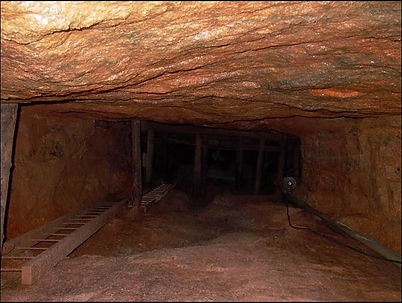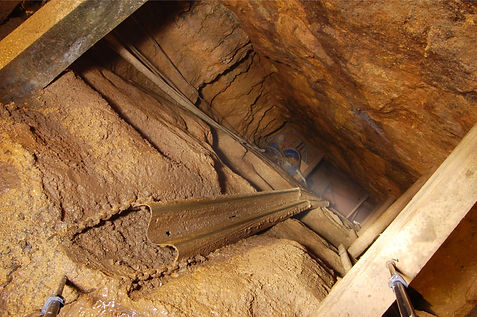

ROSEVALE MINE
Clearing out the old winze in No.2 Level
During the early clearance work in No.1 Level all the rock and debris was tipped down the main stope into a flooded winze in the floor of No.2 Level. Eventually this winze became completely filled. It is shown on an old plan of the mine (dated 1914), but its depth is not given.
Following continued refurbishment of No.2 Level in 2015 the team decided to dig out the old winze. The winze was large, approximately 10 feet long by 4 feet wide, and was flooded to floor of No.2 Level. It was anticipated that it may be 25 - 30 feet deep, possibly with a blocked connection to Deep Adit Level. Digging out began in May 2015. By October a depth of 15 feet had been reached, having removed about 20 tons of backfill. At this point we installed a winch and a modified beer barrel for a kibble. By the end of 2015 the winze had been cleared to a depth of 25 feet, with a total of over 35 tons of fill having been removed. However, there was no evidence of any connection with the Deep Adit Level.
We began to suspect that the winze was sunk purely for the purpose of prospecting the lode below No.2 Level, with the intention of proving the lode in depth and then blocking out a section in preparation for stoping. It is unclear whether water was bailed or pumped from the winze during sinking.

New track laid to the top of the old winze
(photograph courtesy of Nigel Ridgeway)

Looking 20 feet down the winze from No.2 Level, 2016

Looking up the winze from 30 feet down, 2016

Remains of the old ladderway at 50 feet, 2017

Problems were encountered hauling the kibble up the rough footwall, so to overcome this, lengths of second-hand crash barrier were hung down the footwall to act as a runner for the kibble. By the middle of 2016 clearance work had reached a depth of 40 feet, with no sign of a base. An original timber platform had been uncovered at a depth of 30 feet across the out-by side of the winze; we suspected that this may be an interim pumping platform (?). Just below 40 feet evidence of the original but damaged ladderway was encountered; also a wooden windlass drum with the remnants of wire rope was found. By the end of 2016 approximately 100 tons of fill had been removed in total and the winze had been cleared to a depth of over 50 feet below No.2 Level. Considerable evidence of the original timberwork was still in place.
By May 2017 a further 25 tons had been removed; this equated to a total of over 125 tons (167 wagon loads) in almost two years. The winze was now clear to a depth of almost 70 feet below No.2 Level, with still no evidence of a base.
The aim is to attempt to dig out to a depth of up to 100 feet in the hope of encountering the base of the winze and any possible development from it.
Schematic section of the winze (Feb 2018)

Looking up [photograph courtesy of Helga Palmer]

Looking down [photograph courtesy of Nigel Ridgeway]
By the beginning of February 2018, a total of 200 wagon loads of material had been dug out. At a depth of just over 80 feet (~25 metres) we have dug down to the top of what appear to be two levels driven for a short distance east and west of the winze. The backfill in the winze has spilled into each tunnel and there is still a lot of material to dig out before we reach the floor. It is possible that the winze may continue below these levels. The lode is looking very strong, heavily tourmalinised and 3 - 4 feet wide.
Early in May wooden planking across the full width of the winze was reached at a depth of just under 90 feet. This marks the base of the winze, although a square hole in the centre of the planking appears to be a sump. It has taken 3 years with over 250 tons of muck removed by hand to clear out this winze. The lode at the bottom is over 1 metre wide and contains fine cassiterite.

The roof of the tunnel
[photograph courtesy of Wayne Ridgeway]
We intend to leave the winze open with temporary ladderway access and to keep it pumped out.

In our opinion, this winze was sunk as part of exploration carried out in 1910s by Rayfield to prove the lode in depth with a view to blocking out the ground to the west and east below No.2 Leve. This activity may have been curtailed by the start of WWI.